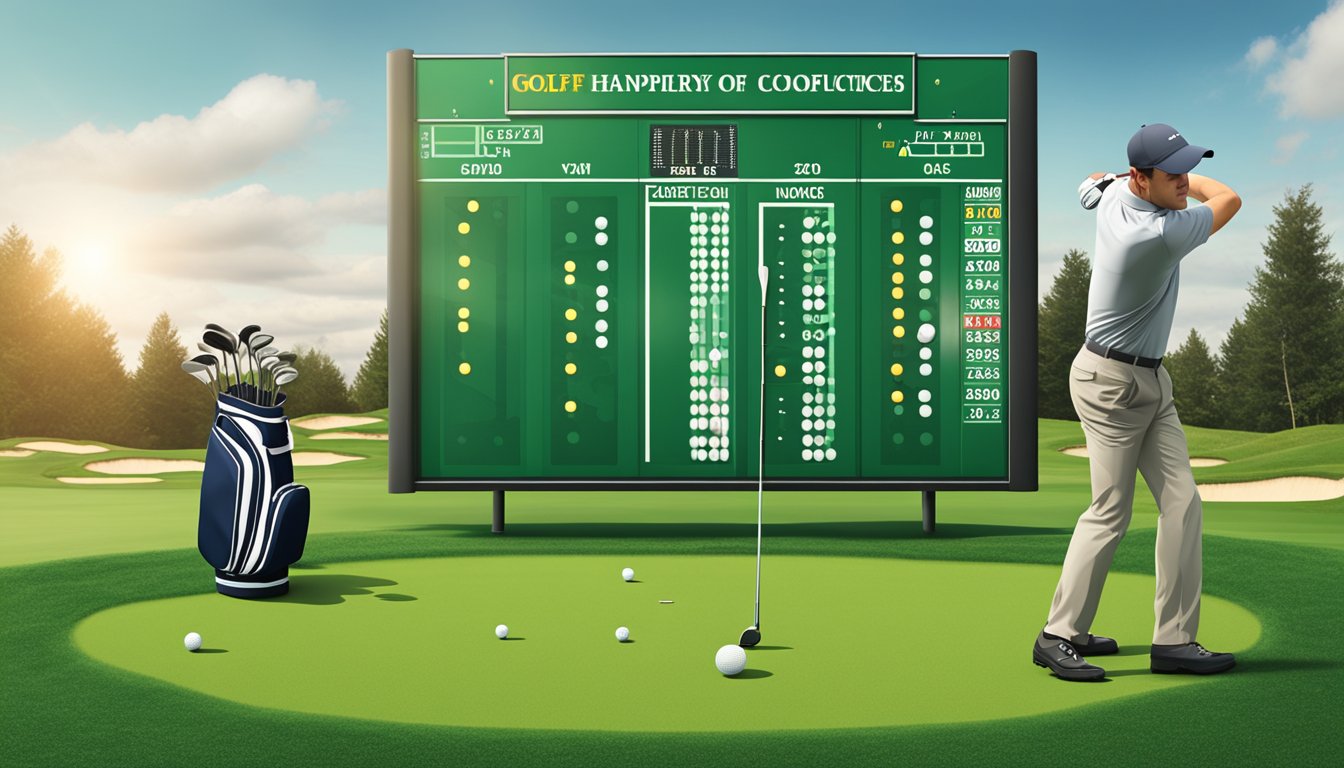If you’re a golf enthusiast, you’re probably familiar with the concept of a handicap. It’s a system that allows golfers of all skill levels to compete on a level playing field by adjusting their scores based on the difficulty of the course. But have you ever heard of a negative handicap? Is it even possible to have a handicap that’s below zero?


The short answer is yes. While it’s not very common, golfers can indeed have a negative handicap. In fact, having a negative handicap is a sign of exceptional skill and consistency on the golf course. But how exactly does it work, and what are the benefits and drawbacks of having a negative handicap? Let’s take a closer look.
Key Takeaways
- A negative handicap in golf is possible and indicates exceptional skill and consistency on the golf course.
- Handicaps are calculated based on a golfer’s performance relative to the difficulty of the course.
- Having a negative handicap can be both beneficial and challenging, and it’s important to understand the system to make the most of it.
Understanding Golf Handicap
https://www.youtube.com/watch?v=Wi3PQweqA5c&embed=true
If you’re new to golf, you might be wondering what a golf handicap is. In short, a golf handicap is a numerical measure of a golfer’s potential ability to play a course. It’s a way of leveling the playing field among golfers of different skill levels, so that everyone has a fair chance of winning.
The USGA Handicap System is used to calculate a golfer’s handicap index, which is a number that represents the golfer’s potential ability to play a course. The handicap index is based on the golfer’s scores from previous rounds, and it’s adjusted based on the difficulty of the course being played.
Your golf handicap is then used to calculate your course handicap, which is the number of strokes you’re allowed to take on a specific course. The course handicap takes into account the difficulty of the course, and it’s designed to give all golfers an equal chance of winning, regardless of their skill level.
A scratch golfer is a golfer who has a handicap of 0.0, which means that they’re expected to shoot par on any course. If a golfer has a handicap that’s lower than 0.0, they’re considered to have a negative handicap.
Having a negative handicap means that you’re an exceptionally skilled golfer, and it’s a testament to your ability to consistently shoot scores that are better than par. While a negative handicap might seem like a good thing, it’s important to remember that it’s still just a numerical measure of your potential ability. The most important thing is to enjoy the game and have fun!
Negative Handicap: Is It Possible?
https://www.youtube.com/watch?v=wGWQ02XgPO8&embed=true
If you are an avid golfer, you may have heard of the term “negative handicap.” But what does it mean? Can you really have a handicap that is below zero? The answer is yes, it is possible to have a negative handicap in golf.
A negative handicap is also known as a “plus” handicap. This is because a golfer with a plus handicap has to add strokes to their gross score to determine a net score. A plus handicap is given to skilled players to indicate that they are better than a scratch golfer.
Consistently performing below par will take your handicap into negative territory. This means that a golfer’s scoring average is better than the course rating. A negative handicap indicates that the golfer consistently scores lower than the expected average for the course. While negative handicaps are rare, they are a sign of exceptional skill and can be achieved by only the best golfers.
A negative handicap is for players that are even better than a scratch golfer, so they have a handicap index that is less than zero. In fact, a golfer with a negative handicap is considered to have the lowest handicap possible. This means that they are the best player on the course and are expected to shoot lower scores than their opponents.
In conclusion, a negative handicap is possible in golf. It is a sign of exceptional skill and is reserved for the best golfers. If you consistently perform below par, you may be able to achieve a negative handicap and become one of the elite players in the game.
How Handicaps are Calculated
https://www.youtube.com/watch?v=Wm0LRY-r1PM&embed=true
If you’re new to golf, you may be wondering how handicaps are calculated. A handicap is a numerical representation of your potential ability, calculated based on your skill level. It’s used to level the playing field between golfers of different skill levels, allowing them to compete against each other fairly.
The Formula
The formula used to calculate your handicap is quite complex, taking into account several factors such as the difficulty of the course, the course rating, and the slope rating. Essentially, it’s calculated by taking your adjusted gross score and subtracting the course rating, then multiplying the result by the slope rating and dividing by 113. This gives you your handicap differential, which is then used to calculate your handicap index.
Impact of Previous Rounds
Your handicap index is based on your average score over your previous rounds, with the most recent rounds being weighted more heavily. This means that if you’ve been playing well lately, your handicap will be adjusted to reflect your improved skill level. Conversely, if you’ve been struggling with your game, your handicap will be adjusted to reflect your decreased skill level.
It’s important to note that your handicap is not a measure of your average score, but rather a measure of your potential ability. This means that even if you consistently shoot above par, you can still have a negative handicap if your skill level is high enough. Conversely, even if you consistently shoot below par, you can still have a positive handicap if your skill level is not as high as it could be.

In summary, handicaps are calculated using a complex formula that takes into account several factors such as the difficulty of the course, the course rating, and the slope rating. Your handicap index is based on your average score over your previous rounds, with the most recent rounds being weighted more heavily. It’s important to remember that your handicap is a measure of your potential ability, not your average score, and that even if you consistently shoot above par, you can still have a negative handicap if your skill level is high enough.
Benefits and Impact of Handicap in Golf

If you are new to golf, you may be wondering what a handicap is and how it can benefit your game. A handicap is a numerical value that represents your playing ability in relation to a scratch golfer. In other words, it is a way to level the playing field and enable golfers of different skill levels to compete against each other.
Leveling the Playing Field
One of the primary benefits of a handicap is that it allows golfers of all skill levels to compete against each other on a more even playing field. Instead of being intimidated by opponents with a lower gross score, you can focus on your net score and adjust your practice and playing ability accordingly.
Improving Your Game
Another benefit of a handicap is that it can help you improve your game. By tracking your scores and dividing them by the difficulty of the course, you can identify your weaknesses and adjust your practice and strategy accordingly. Consistency and dedication to improving your game can result in a higher level of playing ability and confidence.

Choosing the Right Golf Clubs
Your handicap can also help you choose the right golf clubs. Skilled players with a low handicap may require clubs that offer more distance, accuracy, and control, while beginners and higher handicap players may benefit from clubs that offer more forgiveness and precision. Choosing the right clubs can help you improve your short game, birdie opportunities, and overall score.
Overall, a handicap can have a positive impact on your game and enable you to compete in tournaments and events with confidence and respect for your opponents. By practicing and adjusting your game based on your handicap, you can improve your weaknesses, mental toughness, and precision with your golf clubs and tees.
Traditional vs. Modern Handicapping

If you’re an avid golfer, you’re probably familiar with the concept of handicapping. Handicaps are used to level the playing field between golfers of different skill levels. It’s a way of measuring a golfer’s ability and adjusting their score accordingly.
Traditionally, handicapping was a complex process that involved calculating a golfer’s handicap index based on their best 10 rounds out of their last 20. This system had its flaws, as it didn’t take into account the difficulty of the course or the conditions on the day of play.

In recent years, a more modern approach to handicapping has been introduced. The World Handicap System (WHS) is a standardized system used by golfers all over the world. It takes into account the difficulty of the course, the conditions, and the golfer’s performance on the day of play.
Under the WHS, your handicap index is calculated by multiplying the average of your best 8 rounds out of your last 20 by a factor known as the “slope rating” of the course you played on. This system is more accurate and fairer than the traditional system, as it adjusts for the difficulty of the course and the conditions on the day of play.
So, can you have a negative handicap in golf? The answer is yes, you can. If you consistently perform below par, your handicap can go into negative territory. This is also known as a “plus” handicap.
In conclusion, the modern approach to handicapping in golf is more accurate and fairer than the traditional approach. It takes into account the difficulty of the course, the conditions on the day of play, and the golfer’s performance. And yes, you can have a negative handicap in golf if you consistently perform below par.
Frequently Asked Questions

What is a golf handicap?
A golf handicap is a numerical measure of a golfer’s playing ability. It is used to level the playing field so that golfers of different skill levels can compete against each other on an equal basis. The lower the handicap, the better the golfer.
What does a minus handicap mean in golf?
A minus handicap in golf, also known as a negative handicap or a plus handicap, is a handicap that is less than zero. It is given to skilled players to indicate that they are better than a scratch golfer. This means that they can expect to shoot better than par on most courses.
What is a good golf handicap?
A good golf handicap is subjective and depends on the skill level of the golfer. Generally, a handicap of 10 or less is considered good, while a handicap of 20 or more is considered high. However, it’s important to note that a golfer’s handicap is relative to the course rating and slope, so a good handicap on one course may not be as good on another.
Can you have a high negative handicap in golf?
No, you cannot have a high negative handicap in golf. The lowest handicap possible is a zero, which is considered a scratch golfer. A negative handicap indicates that a golfer is better than a scratch golfer, so the lower the handicap, the better the golfer.
What is the maximum handicap in golf?
The maximum handicap in golf is 36.4 for men and 40.4 for women. This is the highest handicap a golfer can have and is typically given to beginners or high handicap golfers. However, some courses may have a maximum handicap limit that is lower than the standard limit.

Is a low golf handicap better than a high one?
Yes, a low golf handicap is better than a high one. The lower the handicap, the better the golfer. A low handicap indicates that a golfer is more skilled and can expect to shoot better than a high handicap golfer on most courses. However, it’s important to note that a golfer’s handicap is relative to the course rating and slope, so a low handicap on one course may not be as good on another.










